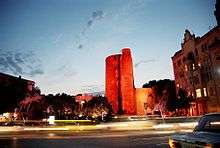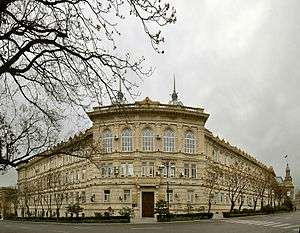Architecture of Baku

The architecture of Baku is not characterized by any particular architectural style, having accumulated its buildings over a long period of time.
In itself, Baku contains a wide variety of styles, progressing through Masud Ibn Davud's 12th century Maiden Tower and the educational institutions and buildings of the Russian Imperial era.
Late modern and postmodern architecture began to appear in the early-2000s. With the economic development, old buildings such as Atlant House have been razed to make way for new ones. Buildings with all glass shell appear around the city, with the most prominent examples being the SOCAR Tower and Flame Towers.
Several monuments pay homage to people and events in the city. The Martyrs' Lane provides views of the surrounding area whilst commemorating the victims of Black January and Nagorno-Karabakh War.[1][2]
Islamic
With Shi'a Islam being the dominant religion of Azerbaijan, there are may Islamic architecture featured buildings that resides in Baku. Religious places have more Islamic calligraphy drawn on the columns and other places on the structure.[3] In December 2000, the Old City of Baku, including the Palace of the Shirvanshahs and Maiden Tower, became the first location in Azerbaijan to be classified as a World Heritage Site by UNESCO.
-
Maiden Tower
-
.jpg)
Divankhane in the Palace of the Shirvanshahs
-
Mahammad Mosque with Minarat, located in Inner City of Baku
Russian Imperial and Azerbaijan Democratic Republic era
There are many buildings built in Baku at the turn of the 20th century that spot Victorian and Western influence in their designs. The city grew into one of the major industrial centres of Russian Empire as oil fields attracted Armenian, Russian and foreign investment.[4]
-
A classical late Russian Empire era buildings
-
House of Hajinsky
Soviet architecture
USSR Council of Ministers' resolution "On measures to further industrialization, improving quality and reducing the cost of construction" and "The removal of excess in the design and construction" in mid-50's has helped to initiate mass housing in Baku.[5]
The architectural image of the country's capital was enriched by a number of interesting in conception projects and highly significant in terms of urban sites, such as the building of the historical Ismailiyya building, which nowadays is the office of the Presidium of National Academy of Sciences of Azerbaijan, the Lenin Palace (now the Heydar Aliyev Palace), as well as marine and railway stations.[5]
-

An apartment building in the Stalinist architecture
Late Modernism and Post-Modern
Baku’s new business districts today has shifted around the Baku city center where many new and tall buildings with Late Modernism and Postmodern architecture. Aside from buildings used for business and institutions, various new residential developments are currently underway, many of which consist of high-rise buildings with a glass exterior, surrounded by American-style residential communities.
Current developments
As a developing city largely influenced by economic oil boom, there are many construction projects that are currently being built that will change the city's skyline in the near future. Some of the construction project are SOCAR Tower, Crescent Beach Hotel, Baku White City, Baku National Stadium, Full Moon Hotel, Baku Hilton Hotel, and the Four Seasons Hotel.[6][7] A lot of the new development has come at the cost of old Sovier-era existing structures. The destruction of the Soviet heritage has created controversy, such as the recent destruction of the Soviet-era 26 Commissars Memorial in 2009 to make way for a new car park.[8][9]
In 2011, Discovery channel's Extreme Engineering program featured these projects that are under construction in Baku.[10]
Skyline
See also
References
- ↑ Baku: The tourist's-eye view of an oil-boom city
- ↑ Память об утратах и азербайджанское общество (Russian)
- ↑ Архитектура исламских мечетей (Russian)
- ↑ Ronald W. Ferrier, James H. Bamberg. The History of the British Petroleum Company: The Developing Years, 1901—1932. — Cambridge University Press, 1982 — Volume, p. 25 — ISBN 9780521246477
- 1 2 Архитектурное развитие города (Russian)
- ↑ UAE's Arabtec bids on Azerbaijan deal, earnings due
- ↑ Baku White City. Coming soon...
- ↑ В Азербайджане против демонтажа мемориала 26 Бакинских комиссаров протестуют только левые (Russian)
- ↑ В Баку начался демонтаж памятника 26 бакинским комиссарам (Russian)
- ↑ "DISCOVERY SCIENCE CHANNEL TO AIR PROGRAM ON BAKU". Retrieved 25 April 2011.









